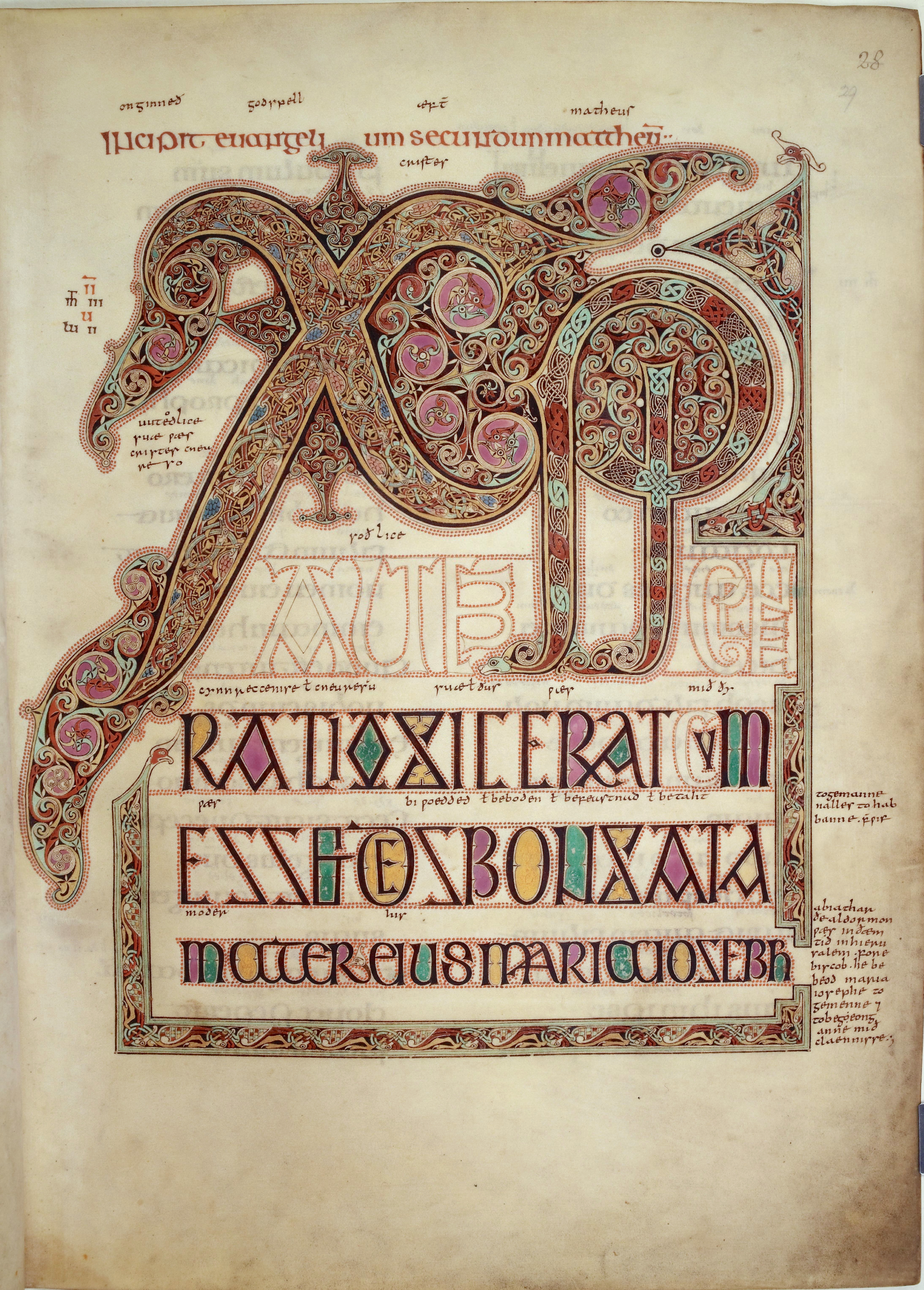|
Insular Script
Insular script is a Middle Ages, medieval script (styles of handwriting), script system originating in Ireland that spread to England and continental Europe under the influence of Hiberno-Scottish mission, Irish Christianity. Irish missionaries took the script to continental Europe, where they founded monasteries, such as Bobbio Abbey, Bobbio. The scripts were also used in monasteries, like Fulda monastery, Fulda, which were influenced by English missionaries. They are associated with Insular art, of which most surviving examples are illuminated manuscripts. It greatly influenced modern Gaelic type and handwriting. The term "Insular script" is used to refer to a diverse family of scripts used for different functions. At the top of the hierarchy was the Insular half-uncial (or "Insular majuscule"), used for important documents and sacred text. The full uncial, in a version called "English uncial", was used in some English centres. Then "in descending order of formality and increas ... [...More Info...] [...Related Items...] OR: [Wikipedia] [Google] [Baidu] |
Alphabet
An alphabet is a standard set of letter (alphabet), letters written to represent particular sounds in a spoken language. Specifically, letters largely correspond to phonemes as the smallest sound segments that can distinguish one word from another in a given language. Not all writing systems represent language in this way: a syllabary assigns symbols to spoken syllables, while logographies assign symbols to words, morphemes, or other semantic units. The first letters were invented in Ancient Egypt to serve as an aid in writing Egyptian hieroglyphs; these are referred to as Egyptian uniliteral signs by lexicographers. This system was used until the 5th century AD, and fundamentally differed by adding pronunciation hints to existing hieroglyphs that had previously carried no pronunciation information. Later on, these phonemic symbols also became used to transcribe foreign words. The first fully phonemic script was the Proto-Sinaitic script, also descending from Egyptian hi ... [...More Info...] [...Related Items...] OR: [Wikipedia] [Google] [Baidu] |
Majuscule
Letter case is the distinction between the letters that are in larger uppercase or capitals (more formally '' majuscule'') and smaller lowercase (more formally '' minuscule'') in the written representation of certain languages. The writing systems that distinguish between the upper- and lowercase have two parallel sets of letters: each in the majuscule set has a counterpart in the minuscule set. Some counterpart letters have the same shape, and differ only in size (e.g. ), but for others the shapes are different (e.g., ). The two case variants are alternative representations of the same letter: they have the same name and pronunciation and are typically treated identically when sorting in alphabetical order. Letter case is generally applied in a mixed-case fashion, with both upper and lowercase letters appearing in a given piece of text for legibility. The choice of case is often denoted by the grammar of a language or by the conventions of a particular discipline. In orth ... [...More Info...] [...Related Items...] OR: [Wikipedia] [Google] [Baidu] |
Book Of Kells
The Book of Kells (; ; Dublin, Trinity College Library, MS A. I. [58], sometimes known as the Book of Columba) is an illustrated manuscript and Celts, Celtic Gospel book in Latin, containing the Gospel, four Gospels of the New Testament together with various prefatory texts and tables. It was created in a Columban monastery in either Ireland or Scotland, and may have had contributions from various Columban institutions from each of these areas. It is believed to have been created 800 AD. The text of the Gospels is largely drawn from the Vulgate, although it also includes several passages drawn from the earlier versions of the Bible known as the ''Vetus Latina''. It is regarded as a masterwork of Western calligraphy and the pinnacle of Insular art, Insular illumination. The manuscript takes its name from the Abbey of Kells, County Meath, which was its home for centuries. The illustrations and ornamentation of the Book of Kells surpass those of other Insular Gospel books in ... [...More Info...] [...Related Items...] OR: [Wikipedia] [Google] [Baidu] |
Lindisfarne Gospels
The Lindisfarne Gospels (London, British Library Cotton MS Nero D.IV) is an illuminated manuscript gospel book probably produced around the years 715–720 in the monastery at Lindisfarne, off the coast of Northumberland, which is now in the British Library in London. The manuscript is considered one of the finest works in the unique style of Hiberno-Saxon or Insular art, combining Mediterranean, Anglo-Saxon art, Anglo-Saxon and Celtic art, Celtic elements. The Lindisfarne Gospels are presumed to be the work of a monk named Eadfrith of Lindisfarne, Eadfrith, who became Bishop of Lindisfarne in 698 and died in 721.Lindisfarne Gospels British Library. Retrieved 2008-03-21 Current scholarship indicates a date around 715, and it is believed they were produced in honour of Cuthbert of Lindisfarne, St. Cuthbert. However, som ... [...More Info...] [...Related Items...] OR: [Wikipedia] [Google] [Baidu] |
Rubric
A rubric is a word or section of text that is traditionally written or printed in red ink for emphasis. The word derives from the Latin , meaning red ochre or red chalk, and originates in medieval illuminated manuscripts from the 13th century or earlier. In these, red letters were used to highlight initial capitals (particularly of psalms), section headings and names of religious significance, a practice known as rubrication, which was a separate stage in the production of a manuscript. Rubric can also mean the red ink or paint used to make rubrics, or the pigment used to make it. Although red was most often used, other colours came into use from the late Middle Ages onwards, and the word rubric was used for these also. Medievalists can use patterns of rubrication to help identify textual traditions. Various figurative senses of the word have been extended from its original meaning. Usually these senses are used within the set phrase "under [whatever] rubric", for example, "unde ... [...More Info...] [...Related Items...] OR: [Wikipedia] [Google] [Baidu] |
Augustine Of Canterbury
Augustine of Canterbury (early 6th century in England, 6th century – most likely 26 May 604) was a Christian monk who became the first archbishop of Canterbury in the year 597. He is considered the "Apostle to the English". Augustine was the Prior (ecclesiastical), prior of a monastery in Rome when Pope Pope Gregory I, Gregory the Great chose him in 595 to lead a mission, usually known as the Gregorian mission, to Britain to Christianization, Christianize King Æthelberht of Kent, Æthelberht and his Kingdom of Kent from Anglo-Saxon paganism. Kent was likely chosen because Æthelberht Bretwalda, commanded major influence over Heptarchy, neighbouring Anglo-Saxon kingdoms in addition to his marriage to Bertha of Kent, Bertha, a Franks, Frankish princess, who was expected to exert some influence over her husband. Before reaching Kent, the missionaries had considered turning back, but Gregory urged them on, and in 597, Augustine landed on the Isle of Thanet and proceeded t ... [...More Info...] [...Related Items...] OR: [Wikipedia] [Google] [Baidu] |
Tironian Notes
Tironian notes () are a form of thousands of signs that were formerly used in a system of shorthand (Tironian shorthand) dating from the 1st century BCE and named after Marcus Tullius Tiro, Tiro, a personal secretary to Marcus Tullius Cicero, who is often credited as their inventor. Tiro's system consisted of about 4,000 signs, extended to 5,000 signs by others. During the medieval period, Tiro's notation system was taught in European monasteries and expanded to a total of about 13,000 signs. The use of Tironian notes lasted into the 17th century. A few Tironian signs are still used today. Note on sign counts Tironian notes can be themselves composites (Typographic ligature, ligatures) of simpler Tironian notes, the resulting compound being still shorter than the word it replaces. This accounts in part for the large number of attested Tironian notes, and for the wide variation in estimates of the total number of Tironian notes. Further, the "same" sign can have other varian ... [...More Info...] [...Related Items...] OR: [Wikipedia] [Google] [Baidu] |
Scribal Abbreviation
Scribal abbreviations, or sigla (grammatical number, singular: siglum), are abbreviations used by ancient and medieval scribes writing in various languages, including Latin, Greek language, Greek, Old English and Old Norse. In modern Textual criticism, manuscript editing (substantive and mechanical) sigla are the symbols used to indicate the source manuscript (e.g. variations in text between different such manuscripts). History Abbreviated writing, using sigla, arose partly from the limitations of the workable nature of the materials (rock (geology), stone, metal, parchment, etc.) employed in record-making and partly from their availability. Thus, lapidary, lapidaries, engravers, and copyists made the most of the available writing space. Scribal abbreviations were infrequent when writing materials were plentiful, but by the 3rd and 4th centuries AD, writing materials were scarce and costly. During the Roman Republic, several abbreviations, known as sigla (plural of ''siglum ... [...More Info...] [...Related Items...] OR: [Wikipedia] [Google] [Baidu] |
Ligature (typography)
In writing and typography, a ligature occurs where two or more graphemes or letters are joined to form a single glyph. Examples are the characters and used in English and French, in which the letters and are joined for the first ligature and the letters and are joined for the second ligature. For stylistic and legibility reasons, and are often merged to create (where the tittle on the merges with the hood of the ); the same is true of and to create . The common ampersand, , developed from a ligature in which the handwritten Latin letters and (spelling , Latin for 'and') were combined. History The earliest known script Sumerian cuneiform and Egyptian hieratic both include many cases of character combinations that gradually evolve from ligatures into separately recognizable characters. Other notable ligatures, such as the Brahmic abugidas and the Germanic bind rune, figure prominently throughout ancient manuscripts. These new glyphs emerge alongside the pro ... [...More Info...] [...Related Items...] OR: [Wikipedia] [Google] [Baidu] |
Ascender (typography)
In typography and handwriting, an ascender is the portion of a Lower case, minuscule grapheme, letter in a Latin-derived alphabet that extends above the mean line of a typeface, font. That is, the part of a lower-case letter that is taller than the font's x-height. Ascenders, together with descenders, increase the recognizability of words. For this reason, many situations that require high legibility such as road signs avoid using solely capital letters (i.e. all-caps). Studies made at the start of the construction of the British motorway network concluded that words with mixed-case letters were much easier to read than "all-caps" and a special font was designed for motorway signs. These then became universal across the UK. See Road signs in the United Kingdom. In many fonts intended for body text, such as Bembo and Garamond, ascenders rise above the cap height of the capital letters. References {{Typography terms [Baidu] |
Evolution Of Minuscule
Evolution is the change in the heritable characteristics of biological populations over successive generations. It occurs when evolutionary processes such as natural selection and genetic drift act on genetic variation, resulting in certain characteristics becoming more or less common within a population over successive generations. The process of evolution has given rise to biodiversity at every level of biological organisation. The scientific theory of evolution by natural selection was conceived independently by two British naturalists, Charles Darwin and Alfred Russel Wallace, in the mid-19th century as an explanation for why organisms are adapted to their physical and biological environments. The theory was first set out in detail in Darwin's book ''On the Origin of Species''. Evolution by natural selection is established by observable facts about living organisms: (1) more offspring are often produced than can possibly survive; (2) phenotypic variation, traits vary am ... [...More Info...] [...Related Items...] OR: [Wikipedia] [Google] [Baidu] |






